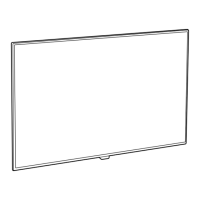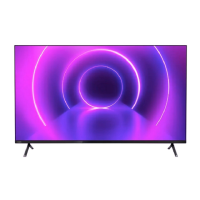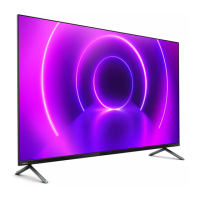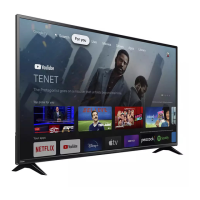Do you have a question about the Philips 65PFL5604 and is the answer not in the manual?
Identifies important safety symbols and warnings for electrical shock and fire hazards.
Provides guidelines for safely placing televisions to prevent injuries, especially to children.
Covers reading instructions, warnings, proper use, and installation of the apparatus.
Information regarding the use and installation of wall mount brackets.
Details about product trademarks, user-serviceable parts, and warranty voiding conditions.
Information regarding FCC and Canadian regulatory compliance for radio frequency energy.
Guidelines on apparatus modifications and requirements for shielded cables.
Instructions for safely positioning the television, considering environment and ventilation.
Warnings related to secure attachment of the apparatus to furniture or walls.
Guidance on recycling packaging and responsible disposal of the product.
Instructions for properly packing the unit for moving or shipping.
Details the TV's features including Google Assistant, Google Play, and various input options.
Lists the accessories included with the TV, such as remote control and batteries.
Explains the meaning of symbols used throughout the user manual.
Guidance on carefully lifting and placing the TV set onto a stable surface.
Instructions for removing protective cardboard attached to the screen.
Step-by-step instructions for inserting batteries into the remote control.
Operations for turning the TV on/off and accessing standby mode.
Activating Google Assistant and using navigation buttons for menu selection.
How to access apps, live TV, and use number and color buttons.
Controls for adjusting volume, muting sound, and changing picture format.
Identifies buttons on the TV's control panel for basic operations.
Connection details for antenna, cable, and satellite set-top boxes.
Information on analog audio, composite video, and HDMI inputs.
Details on digital audio output, Ethernet, USB, and headphone ports.
Guide to connecting antenna, cable, satellite, or IPTV set-top boxes via RF or HDMI.
Ensures all connections are made before plugging in the AC power cord.
Details on using HDMI for superior picture and sound quality.
Information on using composite video and analog audio cables.
Connects to devices via HDMI for high-definition digital video and audio.
Connects to devices with DVI terminals using an HDMI-DVI cable and audio.
Utilizes HDMI-ARC for outputting TV audio to compatible audio devices.
Adjusts HDMI EDID version for compatibility with 4K and HDR signals.
Connects video devices using composite input and analog audio jacks.
Instructions for connecting the TV to the internet using an Ethernet cable.
Steps to connect the TV to a wireless network for internet access.
Connects the TV to a PC with an HDMI terminal for digital connection.
Connects the TV to a PC with a DVI terminal using HDMI-DVI and audio cables.
Connects to external digital audio devices for multi-channel sound.
Instructions for turning the TV on, off, and entering standby mode.
How to increase, decrease, or mute the TV's volume.
Methods for selecting channels using the remote or number buttons.
How to switch between TV and external devices using the SOURCE button.
Steps to access the main Android TV home screen.
Overview of Home menu items like Google Assistant, Settings, and Apps.
Instructions for rearranging channels and managing apps.
Guide on how to search for and install applications from the Google Play Store.
Activating and using Google Assistant for voice commands and queries.
Options to adjust the TV's aspect ratio for different video signals.
Displaying current channel or other information on the TV screen.
Selectable picture styles like Standard, Vivid, Sports, Movie, and Game.
Adjusting picture format and managing closed caption display settings.
Configuring multi-language audio and selecting audio output speakers.
Setting a sleep timer and turning the TV screen off.
Overview of device settings including Network, Channel, Inputs, Picture, and Sound.
Accessing preferences, remote control settings, and personal profiles.
Managing Google and other accounts for expanded TV functionality.
Configuring network connection settings for apps and upgrades.
Instructions for installing and setting up TV channels.
Setting parental controls to restrict access to certain programs or channels.
Configuring film and TV ratings lock for content based on age and rating.
Selecting rating systems for Canadian English or Canadian French broadcasts.
Procedure to change the PIN code for security and parental controls.
Selecting the preferred audio language for digital broadcasts.
Viewing connected inputs and managing standby inputs.
Controlling HDMI devices and adjusting HDMI EDID version for compatibility.
Selection of predefined picture styles for optimal viewing.
Adjusting backlight, contrast, brightness, color, tint, and sharpness.
Choosing sound styles like Standard, Vivid, Sports, Movie, and News.
Adjusting tonal quality with the equalizer and speaker balance.
Configuring dialog, bass, and surround sound enhancements.
Maintains consistent loudness between commercials and programs.
Selecting speaker output and digital audio output format.
Controlling system sounds and setting sleep timers.
Checking license and version number for Google Cast.
Customizing screen saver options like turn screen off, backdrop, or colors.
Setting the TV to turn off automatically after a specified period.
Turning off the TV screen while keeping the audio on.
Performing a factory reset and managing storage.
Checking for system updates and naming the device for identification.
Viewing software version, Netflix ESN, and Android security patch level.
Automatic or manual setting of date, time, and time zone.
Setting the on-screen display language for the TV.
Configuring retail mode settings and performing keyboard setup.
Customizing the home screen by setting channels, previews, and reordering apps.
Configuring search preferences, accounts, and Google Assistant detection.
Adjusting speech settings, including accounts and offensive word filters.
Managing closed caption display for cable and antenna broadcasts.
Customizing caption size, font, color, and background for streaming content.
Adjusting text font, size, color, opacity, text edge, and background.
Enabling high contrast text for improved readability.
Using TalkBack as a screen reader for voice feedback.
Interacting with the device using switches instead of the touch screen.
Configuring text-to-speech output settings.
Adding accessories like Bluetooth devices and searching for them.
Estimating location using Wi-Fi or disabling location services.
Managing Google Play services including force stop, uninstall, and clear data.
Managing app installations from unknown sources and verifying apps.
Creating and managing restricted profiles with PIN codes and allowed apps.
Enabling or disabling usage and diagnostics reporting.
Registering and managing Google accounts for expanded TV features.
Common issues with the remote control and their solutions.
Troubleshooting why the initial setup appears every time the unit is turned on.
Reasons for not watching some RF signal TV programs.
Resolving issues with image display from connected external devices.
Troubleshooting why captions are not displayed entirely or are delayed.
Instructions on how to set the TV's clock.
Checks for power-related problems, including AC connection and reset procedures.
Troubleshooting steps for unresponsive or malfunctioning remote controls.
Resolving issues with no picture/sound, distorted picture, or sound problems.
Addressing issues where screen size changes when switching inputs.
Troubleshooting closed caption display issues, including black boxes.
Guidance on handling software update prompts.
Resolving problems with connecting to the network or poor wireless LAN quality.
Troubleshooting issues with Netflix and VUDU features like playback and rentals.
Addressing poor picture quality or buffering during streaming playback.
Troubleshooting problems connecting to access points using WPS.
Definitions of technical terms and acronyms used in the manual.
Instructions for cleaning the TV's exterior surfaces safely.
Guidance on contacting authorized service centers for repairs.
How to check if the remote control is sending an infrared signal.
Details on screen type, size, aspect ratio, viewing angles, and picture format.
Information on sound output power, equalizer bands, and audio modes.
Specifications for channel coverage, tuning systems, and input/output ports.
Details on power requirements, operating voltage, and temperature range.
Details the terms and conditions of the one-year limited warranty.
Defines what is covered and what is excluded under the warranty.
Information on how to contact the customer care center for warranty service.
Identifies important safety symbols and warnings for electrical shock and fire hazards.
Provides guidelines for safely placing televisions to prevent injuries, especially to children.
Covers reading instructions, warnings, proper use, and installation of the apparatus.
Information regarding the use and installation of wall mount brackets.
Details about product trademarks, user-serviceable parts, and warranty voiding conditions.
Information regarding FCC and Canadian regulatory compliance for radio frequency energy.
Guidelines on apparatus modifications and requirements for shielded cables.
Instructions for safely positioning the television, considering environment and ventilation.
Warnings related to secure attachment of the apparatus to furniture or walls.
Guidance on recycling packaging and responsible disposal of the product.
Instructions for properly packing the unit for moving or shipping.
Details the TV's features including Google Assistant, Google Play, and various input options.
Lists the accessories included with the TV, such as remote control and batteries.
Explains the meaning of symbols used throughout the user manual.
Guidance on carefully lifting and placing the TV set onto a stable surface.
Instructions for removing protective cardboard attached to the screen.
Step-by-step instructions for inserting batteries into the remote control.
Operations for turning the TV on/off and accessing standby mode.
Activating Google Assistant and using navigation buttons for menu selection.
How to access apps, live TV, and use number and color buttons.
Controls for adjusting volume, muting sound, and changing picture format.
Identifies buttons on the TV's control panel for basic operations.
Connection details for antenna, cable, and satellite set-top boxes.
Information on analog audio, composite video, and HDMI inputs.
Details on digital audio output, Ethernet, USB, and headphone ports.
Guide to connecting antenna, cable, satellite, or IPTV set-top boxes via RF or HDMI.
Ensures all connections are made before plugging in the AC power cord.
Details on using HDMI for superior picture and sound quality.
Information on using composite video and analog audio cables.
Connects to devices via HDMI for high-definition digital video and audio.
Connects to devices with DVI terminals using an HDMI-DVI cable and audio.
Utilizes HDMI-ARC for outputting TV audio to compatible audio devices.
Adjusts HDMI EDID version for compatibility with 4K and HDR signals.
Connects video devices using composite input and analog audio jacks.
Instructions for connecting the TV to the internet using an Ethernet cable.
Steps to connect the TV to a wireless network for internet access.
Connects the TV to a PC with an HDMI terminal for digital connection.
Connects the TV to a PC with a DVI terminal using HDMI-DVI and audio cables.
Connects to external digital audio devices for multi-channel sound.
Instructions for turning the TV on, off, and entering standby mode.
How to increase, decrease, or mute the TV's volume.
Methods for selecting channels using the remote or number buttons.
How to switch between TV and external devices using the SOURCE button.
Steps to access the main Android TV home screen.
Overview of Home menu items like Google Assistant, Settings, and Apps.
Instructions for rearranging channels and managing apps.
Guide on how to search for and install applications from the Google Play Store.
Activating and using Google Assistant for voice commands and queries.
Options to adjust the TV's aspect ratio for different video signals.
Displaying current channel or other information on the TV screen.
Selectable picture styles like Standard, Vivid, Sports, Movie, and Game.
Adjusting picture format and managing closed caption display settings.
Configuring multi-language audio and selecting audio output speakers.
Setting a sleep timer and turning the TV screen off.
Overview of device settings including Network, Channel, Inputs, Picture, and Sound.
Accessing preferences, remote control settings, and personal profiles.
Managing Google and other accounts for expanded TV functionality.
Configuring network connection settings for apps and upgrades.
Instructions for installing and setting up TV channels.
Setting parental controls to restrict access to certain programs or channels.
Configuring film and TV ratings lock for content based on age and rating.
Selecting rating systems for Canadian English or Canadian French broadcasts.
Procedure to change the PIN code for security and parental controls.
Selecting the preferred audio language for digital broadcasts.
Viewing connected inputs and managing standby inputs.
Controlling HDMI devices and adjusting HDMI EDID version for compatibility.
Selection of predefined picture styles for optimal viewing.
Adjusting backlight, contrast, brightness, color, tint, and sharpness.
Choosing sound styles like Standard, Vivid, Sports, Movie, and News.
Adjusting tonal quality with the equalizer and speaker balance.
Configuring dialog, bass, and surround sound enhancements.
Maintains consistent loudness between commercials and programs.
Selecting speaker output and digital audio output format.
Controlling system sounds and setting sleep timers.
Checking license and version number for Google Cast.
Customizing screen saver options like turn screen off, backdrop, or colors.
Setting the TV to turn off automatically after a specified period.
Turning off the TV screen while keeping the audio on.
Performing a factory reset and managing storage.
Checking for system updates and naming the device for identification.
Viewing software version, Netflix ESN, and Android security patch level.
Automatic or manual setting of date, time, and time zone.
Setting the on-screen display language for the TV.
Configuring retail mode settings and performing keyboard setup.
Customizing the home screen by setting channels, previews, and reordering apps.
Configuring search preferences, accounts, and Google Assistant detection.
Adjusting speech settings, including accounts and offensive word filters.
Managing closed caption display for cable and antenna broadcasts.
Customizing caption size, font, color, and background for streaming content.
Adjusting text font, size, color, opacity, text edge, and background.
Enabling high contrast text for improved readability.
Using TalkBack as a screen reader for voice feedback.
Interacting with the device using switches instead of the touch screen.
Configuring text-to-speech output settings.
Adding accessories like Bluetooth devices and searching for them.
Estimating location using Wi-Fi or disabling location services.
Managing Google Play services including force stop, uninstall, and clear data.
Managing app installations from unknown sources and verifying apps.
Creating and managing restricted profiles with PIN codes and allowed apps.
Enabling or disabling usage and diagnostics reporting.
Registering and managing Google accounts for expanded TV features.
Common issues with the remote control and their solutions.
Troubleshooting why the initial setup appears every time the unit is turned on.
Reasons for not watching some RF signal TV programs.
Resolving issues with image display from connected external devices.
Troubleshooting why captions are not displayed entirely or are delayed.
Instructions on how to set the TV's clock.
Checks for power-related problems, including AC connection and reset procedures.
Troubleshooting steps for unresponsive or malfunctioning remote controls.
Resolving issues with no picture/sound, distorted picture, or sound problems.
Addressing issues where screen size changes when switching inputs.
Troubleshooting closed caption display issues, including black boxes.
Guidance on handling software update prompts.
Resolving problems with connecting to the network or poor wireless LAN quality.
Troubleshooting issues with Netflix and VUDU features like playback and rentals.
Addressing poor picture quality or buffering during streaming playback.
Troubleshooting problems connecting to access points using WPS.
Definitions of technical terms and acronyms used in the manual.
Instructions for cleaning the TV's exterior surfaces safely.
Guidance on contacting authorized service centers for repairs.
How to check if the remote control is sending an infrared signal.
Details on screen type, size, aspect ratio, viewing angles, and picture format.
Information on sound output power, equalizer bands, and audio modes.
Specifications for channel coverage, tuning systems, and input/output ports.
Details on power requirements, operating voltage, and temperature range.
Details the terms and conditions of the one-year limited warranty.
Defines what is covered and what is excluded under the warranty.
Information on how to contact the customer care center for warranty service.












